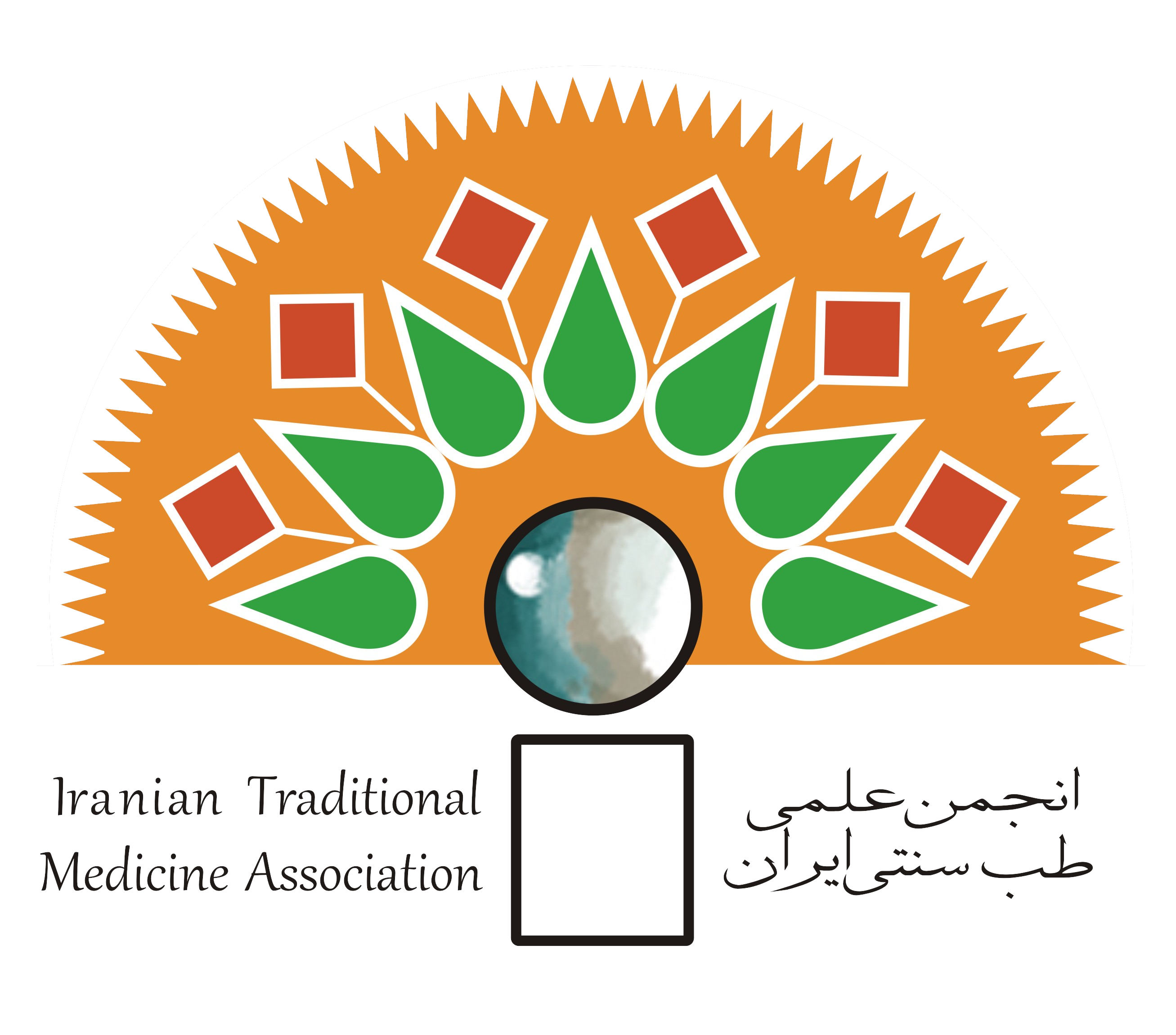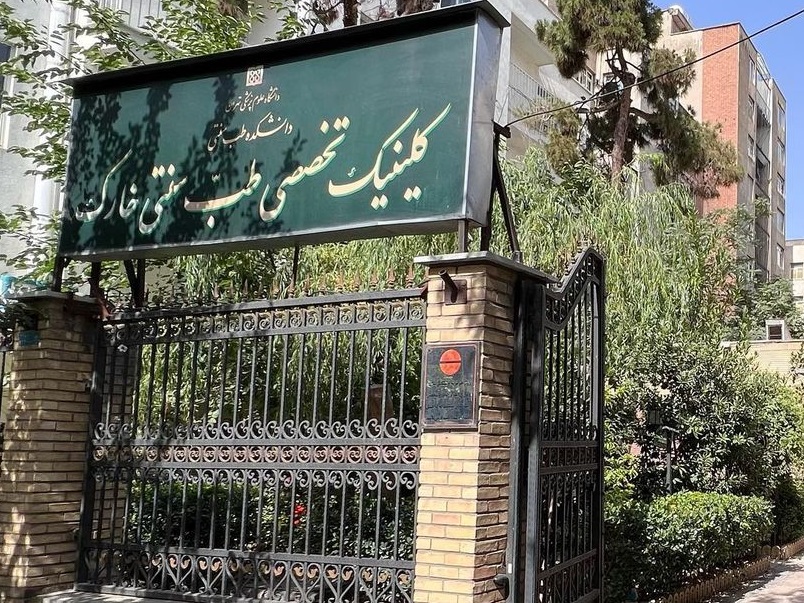Introduction of Persian medicine
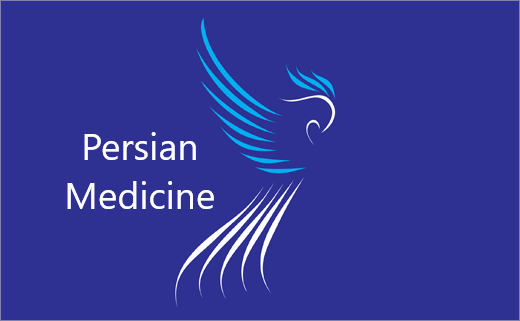
Introduction of Persian medicine
Persian Medicine Theory
Persian Medicine (PM) is a school that views the world as a suitable context created by the wise and omniscient Almighty Lord. PM consists of the sum total of all the knowledge and practices used in diagnosis, prevention and elimination in Persia from ancient times to the present. It is based entirely on practical experience and observations passed down from one generation to another. The structure of PM has two main branches, namely a theoretical branch and a practical branch, each of which also branches into subcategories as follows: 1. The theoretical branch: This branch is a science that discusses the status and changes of the human body as well as the causes and signs of health and disease. 2. The practical branch: This branch is also a science, and although it may remind us of practical procedures, it is really the science of how to maintain health and how to regain it after the occurrence of diseases. Physiological functions of the human body are considered to be based on seven factors in the PM, known as “Umoor-e-Tabee-e-yeh”.
These are as follows:
- Four elements(Arkan),
- Temperament(Mizaj),
- Humors (Akhlat),
- Organs (A’za),
- Spirits (Amah),
- Faculties and Forces(Qova), and VII Functions(Afal).
There is also a terminology called Tabiat (Nature) in the Persian medicine, which plays a key role in the paradigm as a wisdom force in the body to keep it healthy and usher the body back to health after a disease. “Umoor-e-Tabee-e-yeh” means the affairs assigned to Tabiat
The meaning of Tabiat (Nature) in medicine:
Tabiat is a deep philosophical terminology in Persian and Greek philosophies. In medicine, however, it indicates an innate power in the body with tact that controls all aspects of the body. It is not under the control of the person. It was believed that its acts in the best interest of the body. In sudden events that may befall the body, reflexes are under the control of nature. In Persian medicine, it is called “Qovaie Modabereh Badan (The body's tactful power)”.
Some Principles of Tabiat (Nature):
•Wisdom (Hikmat): It means that nature does not work in vain.
•Cosmos: It was a theory originated by the Persians in ancient eras. In this theory, each part of the body is homological with a part in the universe. According to this theory, some events in the body (as the small world) like death, follow the universe (as the great world), considered as a good matter in terms of evolution.
•Attorney: It means that Tabiat (Nature) is the deputy of the soul in maintaining body interests and managing body issues.
•Treatment: This principle is the result of the three past principles. Tabiat had to keep the body healthy; and in disorders, it tries to restore health. Rhazes (865-925 AD) claimed that “Tabiat is the supreme physician”.
Physician and Tabiat (Nature):
Based on Persian medicine principles, the physician is the servant of Tabiat (Nature). He/she should try to help the nature of the patient to restore health. It is mentioned by Persian physicians that a physician can help the nature via the following:
1 . Reinforce body powers in two ways: By life style modifications: There were six principles for health in Persian medicine called “Sette Zaroorieh” (Figure 1) including air (cleanness, temperature, and geographical situation), nutrition (food and drinks), exercise, sleeping and waking, excretion of unnecessary Using spices and medicines
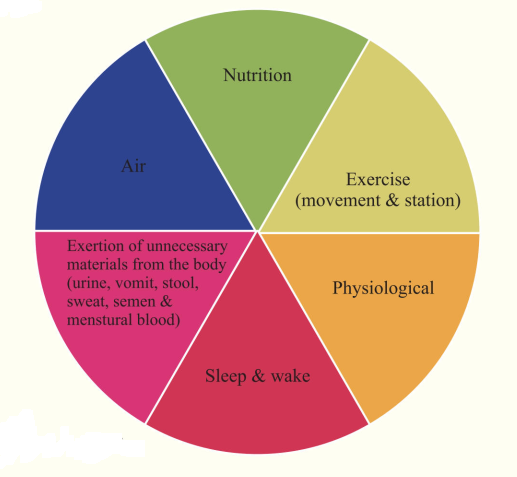
figure 1: There were six principles for health in Persian medicine called “Sette Zaroorieh”
2.Helping nature to help the body avoid harmful agents on the inside or outside.
Therefore, in PM, it is believed that Tabiat (Nature) is the main controller of body health; and physicians should help it to keep the body healthy and also to restore health in case of diseases. There are too many books on Persian medicine and drugs, both simple drugs (herbs, minerals and animals) and formulations (compound drugs). They can be categorized as below:
-Books on simple drugs: They mostly present simple drugs (herbs, minerals and animals) as monographs. They are categorized as the ones that only describe simple drugs to identify and also the ones that describe their pharmacology and therapeutic issues.
-Books on formulations: These books are Persian pharmacopeias, called Qarabadins. In these books, all aspects related to formulations and dosage forms are described.
-Special pharmaceutical books: They are mostly treaties and books on a special subject in pharmacy, for example a book on opium or a book on cardiologic drugs.
-Chapters in comprehensive medical books: In the main Persian medicine reference books like the Canon of Medicine (al-Qanun fi al-Teb) ox Liber Continent (a/ Havi), there are some chapters or parts on simple and compound medicines. Also, in most medical texts, drugs for the treatment of diseases are mentioned.
Affairs related to the nature “Umoor-e-Tabee-e-yeh”
As mentionedbefore, normal functioning andbalance ofthehuman body is based on the 7 factors of
“Umoor-e-Tabee-e-yeh”.
1.Arkan
In Persian medicine, it is believed that all creatures consist of four main substances, called the four elements. They include fire, air, water and earth. Of course, the basis of these elements is based on philosophy and they are different from the actual fire, air, water, and earth available to us, but since the characteristics of each of them are similar to the actual one, they are named in this way. Our body consists of all these elements, but the amount of each is not equal to the other. For example, there may be more fire in your body than water, earth and air, and, in your friend's body, there may be more water than fire, earth and air. This point causes individual differences in people (personalized medicine). For example, some people are brave and some are cowards; some have a strong memory and some are forgetful; some people get skin rash by eating a small amount of dates and others easily eat plenty of dates and have no problems. In Persian medicine, the causes of such individual differences are clearly explained based on "Arkan" and “mizaj\ Each of the Arkan (four elements) has certain functions and characteristics on which the “Mizaj” (temperament) is based.
* Fire: The nature of the fire is hot and dry.
Fire generates agility, rapid penetration, and lightness, and it lowers the coldness. Objects with more fire element in their structure are more agile, faster and more intrusive than others. Having more of the fire element, the person also acts faster and more agile than others.
* Air: The nature of air is hot and moist. When water is heated, it turns into steam. The steamed water has a higher energy level than water itself, because we need to consume energy to convert water to steam, so the air is warmer than water. The air is plastic and flexible, and its role is to create lightness and softness. It also makes porosity and distance between the components of substances. Those who have more air element in their body, also have larger bones than others, because the air has created distance between their bone particles.
Note that in Persian medicine, moisture does not mean immersion in water, but it means flexibility and plasticity.
* Water: The nature of water is cold and moist. It creates plasticity and flexibility in objects. Objects with more water element are more fluid and flexible than others. Having more water, the person is more flexible in dealing with issues.
* Earth: The nature of earth is cold and dry. Earth creates stability in objects. Having more earth element in the body, the person forgets memories later than others. In general, if any of these elements exists appropriately in the body composition, the organs will be able to perform their proper function.
2.Mizaj
“Mizaj” (temperament) is a quality which is a consequence of mutual interactions of the four contradictory primary qualities (hotness, coldness, moisture, dryness) residing within the elements. These elements are so meticulously intermixed with each other that they lie in a very intimate relationship to one another. Their opposite powers intermittently conquer and are conquered until a state of balance is reached that is uniform throughout the whole. This result is called the temperament “Mizaj”. In other words, Mizaj means the dominant quality of the compound object. Mizaj is one of the most important canons of the Persian medicine system. It has an important function in maintaining the ideal healthy state of an individual.
3.Akhlat
“Akhlat" is the plural of “Khelt” (humor). In the PM viewpoint, the food we eat after digestion in the stomach and liver is divided into four major groups of fluids: Yellow bile, blood, phlegm and black bile. Each of these is called humor. Humors also have their own temperament. Blood is hot and moist, phlegm is cold and moist, yellow bile is hot and dry, and black bile is cold and dry. The relationship between Arkan, Mizaj and Akhlat is shown in Table 1 .

The tissues and organs of the body are formed from humors. In PM, it is believed that digestion of food and its transformation into body tissues occurs during the four digestive stages: The first digestion is in the stomach; the second is in the liver, the third digestion is in the vessels, and the fourth digestion happens in the tissue. The waste material from each of these four stages, in some way, is excreted from the body. The waste materials derived from the first digestion is excreted through the stool, those of the second digestion exit the body through urine, and the third and fourth digestion waste material are excreted through sweat, pus, hair, nails, discharge of the ears, nose, etc. The effects and functions of humors are controlled by Tabiat (Nature). Tabiat perfectly knows that at a certain time, which of the humors and how much of that humor should exist in a certain part of the body, and how it should work. Thus, in each individual, every part of the body has a unique natural combination of these humors, and, when they are in balance, the body is healthy. If they became imbalanced or unhealthy, illness is resulted. Because this balance is different for every person, it is necessary for the physician to determine the patient's normal humoral condition before he/she could assess the changes that caused the illness. The characteristics and functions of natural humors of the body are shown in Table 2
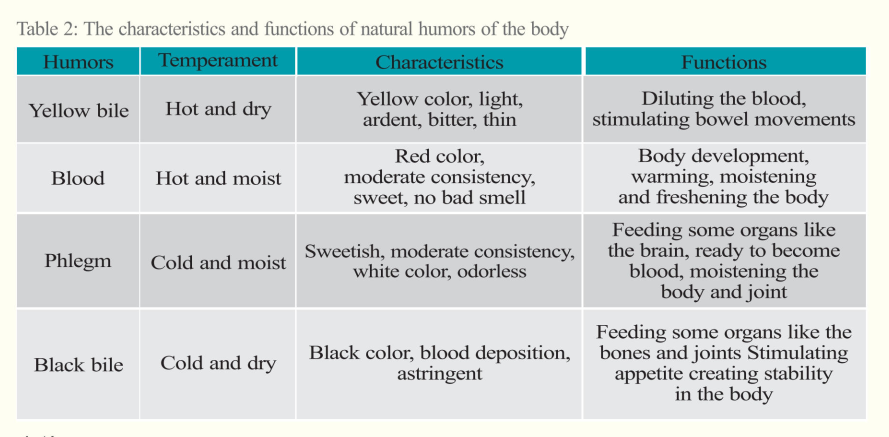
4.A'za
“A'za” is the plural of “Ozv” which means organ. Organs are composed of humors. They are divided into two groups of simple and compound organs. Simple organ: The organ whose components are the same. These organs include bone, cartilage, chord, ligament, nerve, artery, vein, membrane, skin, fat, muscle, hair and nails.
Compound organ: The organs of the body which are composed of simple organs, such as eye, ear, hand, etc.
In terms of application, the organs are categorized as follows:
•Chief organs ( Raiesehy ) : Damage to them is harmful for human survival or reproduction, thus they are very important and vital.
Chief organs are divided into two groups:
- Important for survival: Heart, brain and liver
- Important for reproduction: Testis and ovary
•Non-chief organs (Gheire- Raiesehy). These organs are divided into two groups:
- Servant of chief organs (khadem-al-Raieseh): Each of the chief organs has a servant that delivers its power to the rest of the organs. These servant organs are:
-Arteries: Servant of the heart
-Veins: Servant of the liver
-Nerves: Servant of the brain
-Seminiferous tubules: Servant of the testis
-Fallopian tube: Servant of the ovaries
- Non-servant of chief organs (Gheire-khadem-al- Raieseh):
-Subordinate organs (Maruosehf): Kidney, stomach, spleen, lung
-Non-Subordinate organs (Gheire- Marouseh): Bones and cartilages
Temperament of the organs:
Each organ of the body has its own temperament, which is appropriate to its function.
•Hot tempered organs (respectively from the warmest to the most temperate):
Heart, liver, lung, muscle, spleen, kidney, arteries, veins, skin of the hand palm.
•Cold tempered organs (respectively from the coldest to the most temperate):
Fat, hair, bone, cartilage, chord, ligament, membrane, nerve, spinal cord, brain, skin.
•Moist tempered organs (respectively from the wettest to the most temperate):
Fat, brain, spinal cord, breast tissue, testis tissue, lung, liver, spleen, kidney, muscle, skin.
•Dry tempered organs (respectively from the driest to the most temperate):
Hair and nail, bone, cartilage, ligament, chord, membrane, arteries, veins, motor nerve, heart, sensory nerve, skin.
5.Arwah
“Arwah ” is plural of “Ruh” (spirit) which is a very soft and ethereal physical body composed of steam aroused from the good and fine part of normal humors. The spirit is gentle, smooth, and moving. It is worth noting that “Rooh ” in Persian medicine is the medical spirit that is in the body and discussed in the natural sciences and differs from the immaterial soul that is discussed in theology. There are three types of medical spirit:
1) Vital spirit (Rooh-e- Hayvani) that is in the heart and spreads by the blood in the arteries throughout
the body.
2) Natural spirit (Rooh-e-Tabiee) that is in the liver and promotes the growth and development of the
body.
3) Sensual spirit (Rooh-e-Nafsani) that is in the brain and involved in nervous system functions and
mental-psychological phenomenon.
In a healthy person, Arwah are under the strict control of Tabiat. In the other words, Tabiat manages Amah in such a way that everything goes well for the health of the body.
6.Qova
“Qova” is the plural of“Qoveh” and means the forces and faculties that cause interactions in the body. There are three types of forces in the body:
1) Vital forces (Qovaye- Hayvani) that create movement, energy and vital functions of the body. They
are also the source of feeling scared or angry. In other words, the vital force freshens the body to receive the natural and sensual spirits.
2) Natural forces (Qovaye-Tabiee) that perform the nourishment of the tissues and organs.
3) Sensual forces(Qovaye-Nafsani) that make sense, movement, and the ability to judge and decide.
Natural and sensual forces are subdivided into specific categories as follows: Natural forces (Qovaye-Tabiee)'.
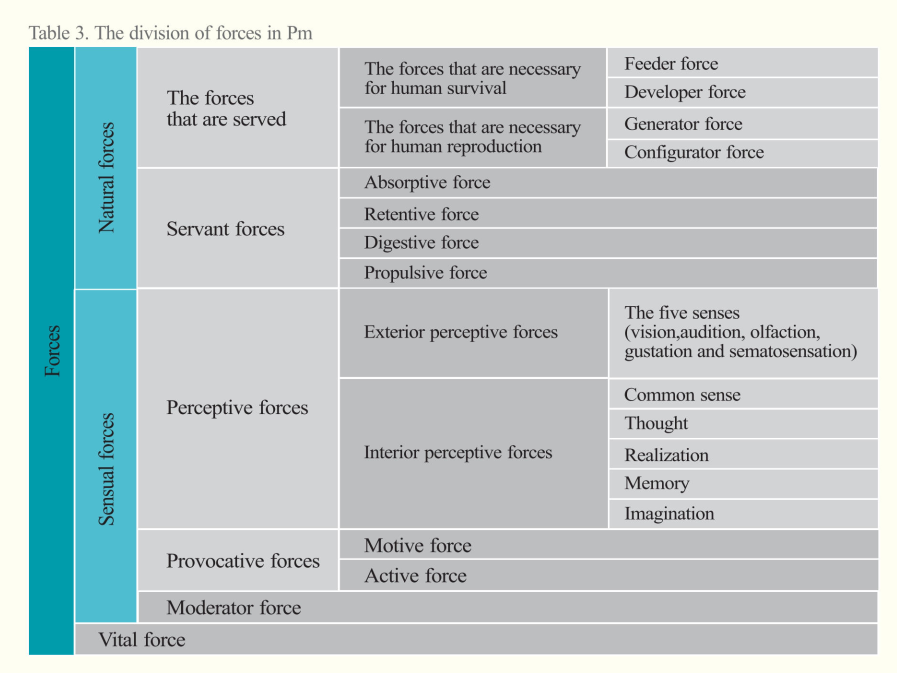
7.Afal
“Afal” means body functions as a result of the interaction of forces. Afal are divided into two parts:
•Single functions (Afal-e-Mofrad): Functions that are performed with one force, such as absorption or repulsion.
•Compound functions (Afal-e-Morakkab): Functions that are performed with two or more forces, such as appetite, which comes from absorptive force and perceptive force.
The purpose of all natural affairs (Umoor-e-Tabee-e-yeh) is to perform body functions completely and correctly. In other words, natural affairs are like an interconnected chain in which the integrity and balance of all its parts are necessary to achieve a proper function. The cause of an impairment of function or the occurrence of any disorder in human health can be explained by a review of this chain.
For more information, please download:
01-International view to traditional medicine in healthcare system
02- Persian medicine: history, theory and principles of treatment
03- Official and governmental document and structures to support traditional medicine in Iran
04- Schools of Persian medicine and associated departments at university
- Tehran University of Medical Sciences (TUMS)
- Shaid Beheshti University of Medical Sciences (sbmu)
- Iran University of Medical Sciences (iums)
- Mashhad University of Medical Sciences (mums)
- Kerman University of Medical Sciences (kmu)
- Qom University of Medical Sciences (muq)
05-Research and research centers in Persian medicine
06- Persian medicine and covid-19
07- Integration of Persian medicine services into health houses network in rural areas
08- Persian medicine festival
09- the selected unique concepts in Persian medicine (below image)

 ادمین انجمن علمی طب سنتی ایران
ادمین انجمن علمی طب سنتی ایران
